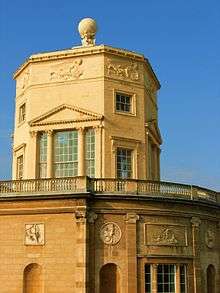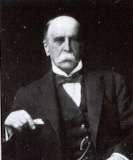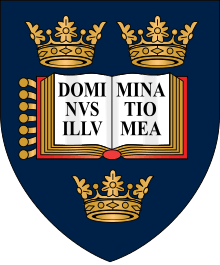Green Templeton College, Oxford
| Colleges and halls of the University of Oxford | ||||||||||||
| Green Templeton College | ||||||||||||
 | ||||||||||||
|
| ||||||||||||
| College name | Green Templeton College | |||||||||||
| Named after | Dr Cecil Howard Green and Sir John Templeton | |||||||||||
| Established | 2008 | |||||||||||
| Sister college | St Edmund's College, Cambridge | |||||||||||
| Principal | Denise Lievesley from October 2015[1] | |||||||||||
| Graduates | 300[2][3] | |||||||||||

| ||||||||||||
| Homepage | ||||||||||||
| Green Templeton Boat Club | ||||||||||||
 | ||||||||||||
| Blazon | Or between two Flaunches Vert on each a Nautilus Shell the aperture outwards Or a Rod of Aesculapius Sable the Serpent Azure | |||||||||||
Green Templeton College (GTC) is a constituent college of the University of Oxford in the United Kingdom. It is the university's newest college, having come into existence on 1 October 2008 from the merger of Green College and Templeton College.[4] The merger between Green College and Templeton College was the first in the University's modern history. After being approved by the University Council and the Governing Bodies of both colleges, it was formally announced in July 2007. Green Templeton College (GTC) was officially opened on 1 October 2008.
As an all-graduate college, Green Templeton has a single common room for its Students and Fellows, to encourage their interaction. The college focuses on a variety of subjects, especially those in the medical and life sciences, the management sciences, and a range of social sciences.
The college is located on the previous Green College site on Woodstock Road in North Oxford and is centred on the architecturally important Radcliffe Observatory,[5] an 18th-century building, modelled on the ancient Tower of the Winds at Athens.
The college has formal ties with Green College, University of British Columbia, which similarly owes its inception to the generosity of Cecil H. Green.
History
Though by Oxford standards both Green College and Templeton College were relatively young colleges, they each had their own individual history and established culture. Neither was formed as a traditional Oxbridge college.
Green College
Established in 1979, Green College was one of the youngest colleges of the University and was named after its main benefactors: Dr Cecil H. Green, founder of Texas Instruments, and his wife Dr Ida Green. It was one of three colleges established due to his generosity (the others being Green College, University of British Columbia and The University of Texas at Dallas).[6]
Green College was dedicated to human welfare in contemporary society. This was interpreted as an academic focus on medicine. Related disciplines, such as education, the environment and social sciences, however, were also covered.[6]
30% of its students studied in the field of medicine; about 20% were engaged in postgraduate medical research; and, subjects such as social work, environmental change and education studies were other strongholds.[6]
Templeton College
Templeton College was founded when the late Sir John Templeton gave an endowment to the Oxford Centre for Management Studies to raise professional standards in British management. The endowment was one of the largest endowments ever made to a British educational establishment, and the Centre was renamed Templeton College in his memory.
The college emphasised a commitment to lifelong individual development and aimed to bring together leaders from various fields to explore key issues in management and related policy areas.
It was based previously at Egrove Park, nearby Kennington village. Its buildings were opened in 1969 and were granted listed status in 1999.
Coat of arms
Green Templeton College's armorial bearings combine elements from both Green and Templeton's original coats of arms, capturing the spirit of each college's history and character.[7]
Its shield comprises two primary symbols: the rod of Aesculapius and the Nautilus shell. The rod of Aesculapius was the principal charge of Green College's coat of arms. In Greek mythology, Aesculapius, the son of Apollo, was a medical practitioner. The serpent coiled around his staff symbolises the healing arts. The Nautilus shell was chosen by Sir John Templeton, as symbolising evolution and renewal, and was adopted by Templeton College in 1984.
Green Templeton College's crest depicts an heraldic representation of the Sun behind the astronomical device for Venus (♀), acknowledging the historic transit of Venus across the Sun in 1761, which astronomical event prompted the foundation of the Radcliffe Observatory. The crest is emblazoned:
- (On a Helm with a Wreath Or and Vert) In front of a Sun in splendour the rays voided Or the Astrological Symbol for Venus Vert.
Buildings and grounds
The Radcliffe Observatory
Situated at the heart of the College campus, and emblematic of GTC, the Radcliffe Observatory is Green Templeton College's best-known building, and among Oxford's finest too. The observatory was built to enhance Britain's capability to study cosmological events, such as that of the 1761 transit of Venus.
The astronomer Dr Thomas Hornsby, who observed the transit of Venus across the Sun in 1769, suggested the building of an observatory. Building began in 1772 as planned by the architect Henry Keene, and financed by the estate of Dr John Radcliffe (1652–1714). However, Keene died in 1776, before the observatory was completed. After his death, it was completed by James Wyatt (1746–1813). Wyatt based his design on the Greek Tower of the Winds.
Atop the Observatory rests the Tower of Winds. Beneath the Tower are three levels, with rooms on each level. The ground floor is today used as the College dining room. The first floor was originally the library, but is now the college's student-fellow Common Room. The third floor is an octagonal observing room, which is now empty except for some of the original furniture.
The Observatory was a functioning observatory from 1773 until its owners, the Radcliffe Trustees, sold it in 1934 to Lord Nuffield, who then presented it to the Radcliffe Hospital. In 1936 Lord Nuffield established the Nuffield Institute for Medical Research there. In 1979 the Nuffield Institute relocated to the John Radcliffe Hospital, and the Observatory was taken over by Green College.
The Norham Gardens Site

A short walk from Green Templeton's main buildings is 13 Norham Gardens. In 1905 Sir William Osler was appointed to the Regius Professorship of Medicine at Oxford. In 1907, Sir William acquired 13 Norham Gardens, one of the finest houses in Oxford at the time. During the fourteen years of his Regius Professorship, Osler made Norham Gardens a meeting place for academics from all over the world. It became a favourite of medical students, physicians, and scientists, even receiving the label of 'The Open Arms' for the warmth it exuded.
After Osler, 13 Norham Gardens was occupied by another Regius Professor, Sir George White Pickering and after him, the Regius Professor Sir Richard Doll, who was the last Regius Professor to live there. The property of 13 Norham Gardens was then acquired by Green College.
Today, Norham Gardens houses the Osler-McGovern Centre. This Centre serves two functions. Firstly, it follows in Sir Osler’s footsteps by uniting scholars, lecturers and academics. The Centre promotes the art and science of medicine through its workshops, conferences, visiting scholars and post-doctoral Fellows. Secondly, 13 Norham Gardens is also home to the Reuters Institute for the Study of Journalism (RISJ), established in 2006, and based at Green Templeton College.
Housing
Green Templeton College has housing on the main site and various annexes. On-site housing includes the Doll Building (built in 1981) with 30 student rooms, Walton Building with 3 student rooms, Observer's House with 13 student rooms and New Block with 4 student rooms.[8] Furthermore, the college has various student rooms in the Lord Napier House (Observatory Street), 2- and 3-bedroomed terraced houses in Observatory Street, various student rooms on St Margaret's Road, 1- and 2-bedroom flats in Rewley Abbey Court and 1- and 2-bedroom flats in Norham Gardens.
Facilities
Green Templeton also provides laundry facilities, a lecture theatre (the Abraham Lecture Theatre), a seminar/presentation room (the Barclay Room), and a computing room with 6 Windows computers.[9] There are two 24-hour-access libraries on-campus: a management library (Management Studies Library) and a medical/social science library (Medical Library).[9] The Management Studies Library is adjacent to the Observer's House, and the Medical Library is adjacent to the Radcliffe Observatory.[9] Since August 2014, Green Templeton has a on-site 171 square meter gym with rowing machines, spinning bikes, threadmills and weights located between the main site and Observatory street. [10]
Future developments
In the next phase of development, the area to the north-east of the College is to be developed, allowing for the extension of the College's academic departments and residential accommodation. Furthermore, the University of Oxford is redeveloping the adjoining old Radcliffe Infirmary site, which is to be known as the Radcliffe Observatory Quarter.[11]
Student life
Green Templeton offers a wide variety of activities to its students. The various Green Templeton College clubs and societies include the Boat Club, the Book Club, Choir, Golf Society, LGBT Society, Medical Anthropology Society, Richard Doll Society, and Music Society. College events include the annual college Garden Party, the Summer Ball, the Human Welfare Conference, "Welfare and Wine", formals, and themed "bops" (discos or college parties), held throughout the year. Lecture series are routinely held for those interested, including the Green Templeton Lectures and those held by the Reuter's Institute.
The college is also active in various sports, especially rowing. It co-owns a boathouse on the River Isis with a sizeable fleet, and Green Templeton Boat Club has been competing successfully since its establishment in 2008. Other sports at Green Templeton College include badminton, basketball, cricket, croquet, football, golf, netball, rugby, running, squash and tennis. The College also has on-site tennis and squash courts.[12] In addition to this, all students of the college are entitled to free membership at the Iffley Road Sports Centre.[12]
The college bar, known as the "Stables Bar", is open for drinks in the evenings, and serves as a meeting place during the day.[13][14]
Green Templeton is actively involved in charity work, supporting a local and an overseas charity every year. Both the Graduate Common Room and the College Charity Committee organise numerous events throughout the year, both at Green Templeton College and in Oxford.
Green Templeton College's strong ties with the clinical medicine community are fostered through its affiliation with Osler House. Osler House is Oxford University's club for medical students and is open to students and Fellows involved in research in a range of topics related to human health and welfare.[15] The friendly and comfortable ambience of Osler House is focused around a games room which has pool and table football facilities.
The college publishes a newsletter every term, called In Transit, as well as an annual Green Templeton College alumni magazine, called The GTC Magazine (formerly, albeit for Templeton College only, Templeton Views),[16] and the college Graduate Common Room circulates a weekly electronic newsletter.[17][18]
Gallery
- Top of Radcliffe Observatory, Green Templeton College, Oxford.
- Observers House, Green Templeton College, Oxford.
- A view of the gardens, Green Templeton College, Oxford.
- Lankester Quad, Green Templeton College, Oxford.
- Green Templeton College in the snow, Oxford.
People associated with Green Templeton College
- Kunal Basu, Indian-born British fiction author
- Dame Valerie Beral, Australian-born British epidemiologist
- Colin Bundy, First Principal of Green Templeton College
- Rory Collins, epidemiologist
- E. David Cook, theologian
- Sarah Darby, epidemiologist
- Sir Richard Doll, epidemiologist, first Warden of Green College
- Michael Earl, Pro-Vice Chancellor of the University of Oxford
- Sir Vernon Ellis, Barclay Fellow (2002–06) and Chair of the British Council
- Sanjaya Lall, World Bank economist, Professor of Economics and Fellow of Green College
- Peter Friend, surgeon, Professor of Transplantation and Director of the Oxford Transplant Centre
- Derrick Gosselin, Belgian/Flemish engineer and economist
- Dr Cecil Green, British-born American engineer, founder of Texas Instruments
- John Lennox, Irish mathematician
- Sir Richard Peto, epidemiologist
- Stein Ringen, Norwegian sociologist and political scientist
- Rosemary Stewart, business theorist
- Sir Crispin Tickell, diplomat and environmentalist, third Warden of Green College
- Michael von Clemm, American businessman, restaurateur, anthropologist, former President of Templeton College
- Lord Walton, politician (Life Peer), second Warden of Green College
- Steve Woolgar, sociologist
See also
- Alumni of Green Templeton College
- Fellows of Green Templeton College
References
- ↑ "Green Templeton College elects Professor Denise Lievesley as Principal". 2015-03-15. Retrieved 2015-03-21.
- ↑ "Green Templeton College". Oxford University Graduate Studies Prospectus 2007/08. Retrieved 2009-11-29.
- ↑ www.oxford.world-guides.com
- ↑ "Merger to create new Oxford graduate college". University of Oxford. 3 July 2007.
- ↑ "Green Templeton College: History and Architecture".
- 1 2 3 "A Short History of Green Templeton College, Oxford" (PDF). Green Templeton College, Oxford.
- ↑ "Bibliography of Present Officers". College of Arms.
- ↑ "Green Templeton On site Accommodation". Green Templeton College, Oxford.
- 1 2 3 "Green Templeton Graduate Common Room - Academic Facilities". Green Templeton College, Oxford.
- ↑ "Green Templeton College - Gym". Green Templeton College, Oxford.
- ↑ Turnberry Consulting. (2009.) University of Oxford Radcliffe Observatory Quarter: Mathematical Institute: Planning Statement, University of Oxford.
- 1 2 "Sports Facilities". Green Templeton College, Oxford.
- ↑ "Social Events". Green Templeton College, Oxford.
- ↑ "The College Bar". Green Templeton College, Oxford.
- ↑ "Osler House". Osler House.
- ↑ "Templeton College publications archive". Green Templeton College, Oxford.
- ↑ "In Transit". Green Templeton College, Oxford.
- ↑ "Communications". Green Templeton College, Oxford.

